Nandina (Heavenly Bamboo or Nandina Domestica): Plant Care and Growing Guide
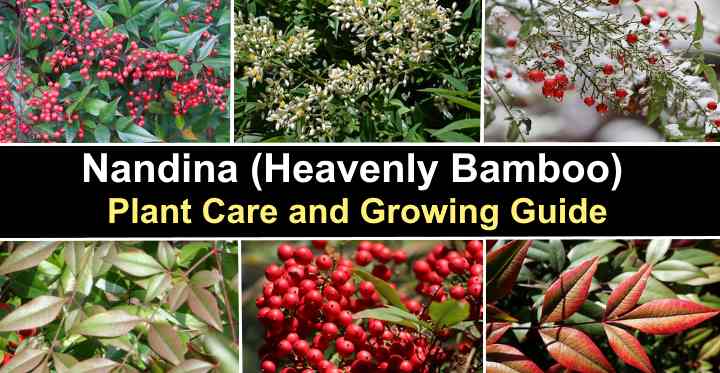
Nandina (Nandina domestica) is an evergreen, ornamental landscape shrub with brightly colored leaves and crimson red berries. Nandina shrubs go by the common names of heavenly bamboo, Chinese sacred bamboo, or sacred bamboo. Nandina is a low-growing shrub that is popular in gardens due to its bright red or pink foliage that decorates the bush in the spring, fall, and winter.
Although nandina is popular in many residential gardens, its berries are poisonous to birds. Additionally, it’s considered invasive in many areas. However, if you want to grow this heavenly bamboo in your yard, you can choose from many nandina cultivars that don’t produce flowers and fruit, therefore are safe for growing in gardens, as well as non-invasive cultivars.
This article is a guide to growing heavenly bamboo in a front or backyard. You will also find out how to avoid any issues with caring for the nandina ornamental shrub so that you can enjoy its beautifully colored leaves during spring, fall, and winter.
Nandina (Nandina domestica) Facts
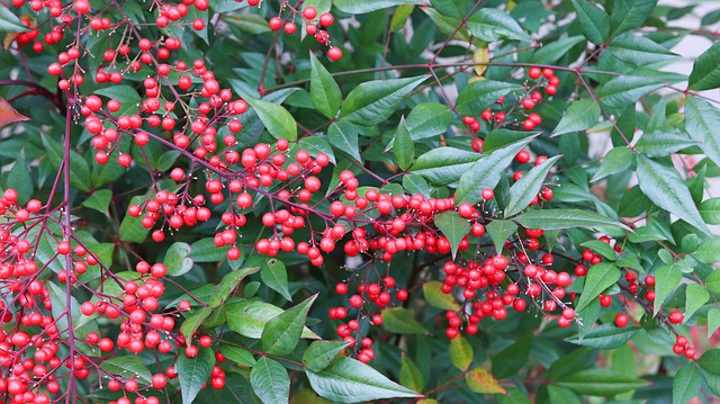
Nandina domestica (heavenly bamboo) shrub has red berries and summer green foliage before turning red in autumn
Nandina is an ornamental garden shrub with upright growth. The attractive features of nandina are its bright red berries and colorful foliage. Nandina bushes bloom in spring, and new leaves appear reddish-pink. Summer colors are green before the leaves turn red, and berries appear in fall and persist through winter.
Nandina thrives in USDA zones 6 to 9 and grows best in full sun or partial shade. Usually, nandina shrubs lose leaves when temperatures drop to 10°F (-12°C), and stem damage occurs at 5°F (-15°C). However, the robust, hardy shrub usually recovers well.
Nandina domestica has medium growth and matures between 6 and 8 ft. (1.8 – 2.4 m) tall and up to 3 ft. (1 m) wide. Nandina growth rate is between 12” and 24” (30 – 60 cm) per year.
Due to its suckering nature, nandina can be a high-maintenance shrub that requires regular pruning to prevent it from spreading too much.
One reason nandina shrubs are popular in gardens is that they are adaptable to most conditions. Nandina grows well in most types of soils, survives drought well, and is relatively pest and disease resistant.
What Does Nandina Shrub Look Like?
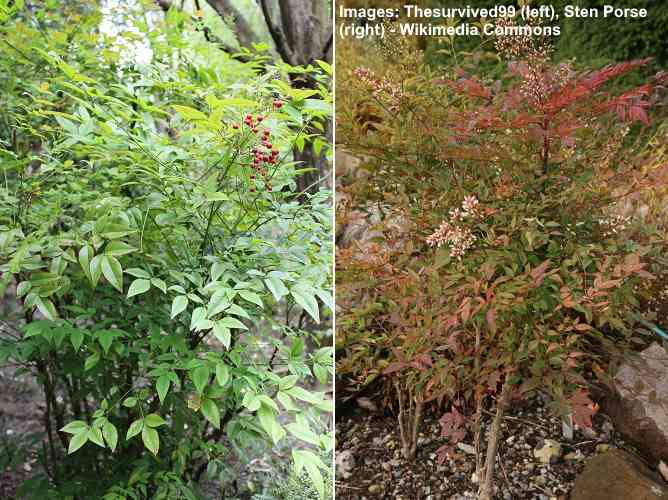
Nandina shrubs have upright growth habit
A nandina shrub has upright, cane-like stems and narrow lanceolate leaves that look like bamboo. Because nandina bush is native to Asia and looks like bamboo, it has common names like Chinese sacred bamboo and heavenly bamboo.
From fall to spring, red leaves and bright red berries decorate the upright nandina shrub. During summer, the shrub’s foliage and berries are varying shades of green.
Types of Nandina
There is only one species of nandina—Nandina domestica—in the genus Nandina. However, several nandina cultivars are worthy of consideration.
The species nandina plant grows up to 7 ft. (2 m) tall and 5 ft. (1.5 m) wide. Its leaves are glossy green during summer, but they are shades of reddish-purple or dusty pink during fall and winter. Bright red berries appear in the fall and persist throughout winter.
Some of the types of heavenly bamboo shrubs include the following:
Nandina ‘Gulf Stream’
The nandina ‘Gulf Stream’ is the most popular type of heavenly bamboo growing in garden landscapes. The ornamental evergreen shrub has pinnate leaves, abundant red berries, and clusters of tiny white flowers. The nandina ‘Gulf Stream’ foliage emerges a bronze-orange color before turning green then shades of red in the fall.
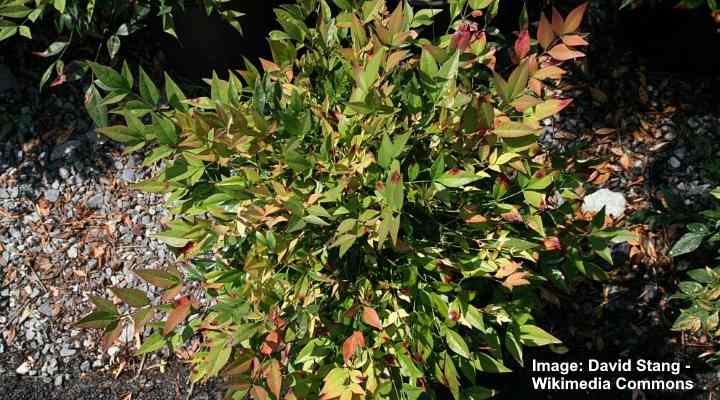
Nandina domestica ‘Gulf Stream’ is a smaller cultivar of nandina
‘Gulf Stream’ nandina shrubs grow between 3 and 4 ft. (1 – 1.2 m) tall and up to 5 ft. (1.5 m) wide. The sun-loving shrub grows well in landscapes as a low informal hedge, shrub borders, container gardens, foundation planting, or specimen plant.
Nandina ‘Sienna Sunrise’
Nandina ‘Sienna Sunrise’ is a small ornamental shrub that has bright red foliage in spring and fall. The nandina ‘Sienna Sunrise’ grows 4 ft. (1.2 m) tall and 2 ft. (0.6 m) wide. This nandina shrub is suitable for compact gardens or containers. Because it doesn’t produce berries, it’s safe if birds frequent your garden.
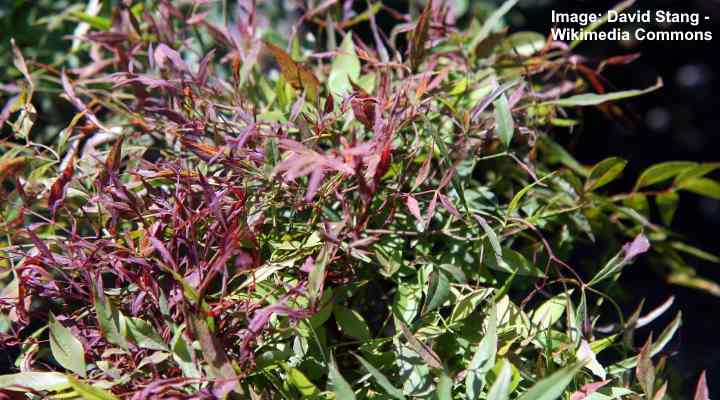
Nandina domestica ‘Sienna Sunrise’
Nandina domestica ‘Lemon Lime’
Nandina domestica ‘Lemon Lime’ is a dwarf nandina shrub that has bright green foliage in spring and fall. This shrub doesn’t flower or produce berries and grows up to 4 ft. (1.2 m) tall.
Heavenly Bamboo ‘Moyers Red’
Heavenly Bamboo ‘Moyers Red’ is a semi-dwarf landscape nandina shrub, growing up to 6 ft. (1.8 m) tall and 5 ft. (1.5 m) wide. This nandina bush features clusters of pink flowers and masses of crimson red berries. The green leaves turn dark red in autumn.
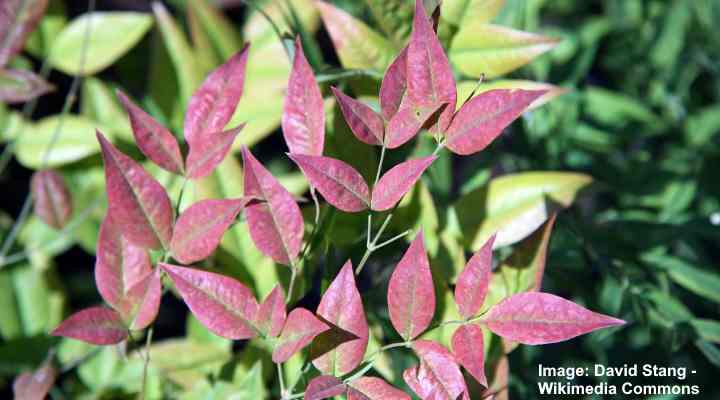
Nandina domestica ‘Moyers Red’
Nandina ‘Flirt’
Nandina ‘Flirt’ is a low-growing mounding shrub suitable for ground cover in full sun. The spectacular leafy foliage is dark purplish-red in spring and summer, turning to bright red in winter.
Nandina domestica ‘Fire Power’
Nandina domestica ‘Fire Power’ is a compact evergreen shrub with glossy lanceolate leaves. The small mounding nandina shrub has yellowy-green leaves in the summer that turn warm red and orange shades in the fall. Nandina ‘Fire Power’ shrub doesn’t flower or produce berries. It grows up to 1.6 ft. (0.5 m) tall and wide.
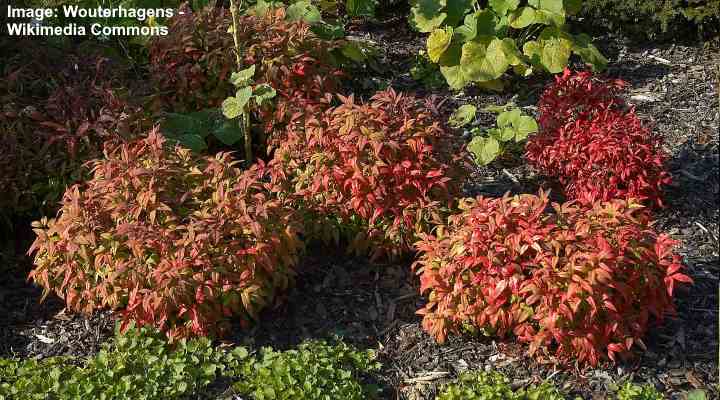
Nandina domestica ‘Fire Power’
Nandina domestica var. leucocarpa
Nandina domestica var. leucocarpa is a tall, non-invasive nandina shrub that produces white berries and has attractive pale green leaves. This is one of the nandina shrubs that closely resembles the look of actual bamboo.
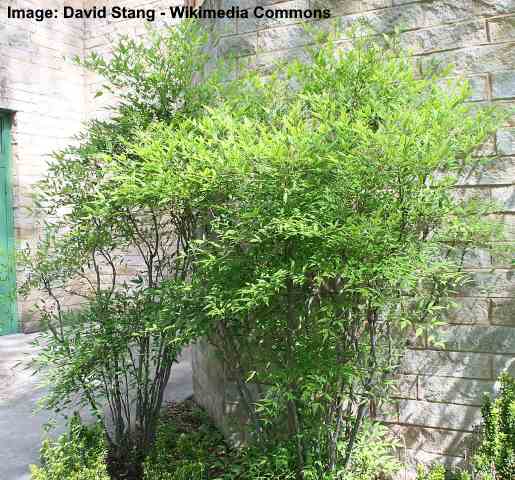
Nandina domestica var. leucocarpa
Nandina domestica ‘Otafukunanten’
Nandina domestica ‘Otafukunanten’ is a miniature nandina shrub that doesn’t grow taller than 2 ft. (0.6 m). Its round, mounding growth, beautiful pinkish-red shiny leaves, and lack of berries make this an attractive landscaping shrub.
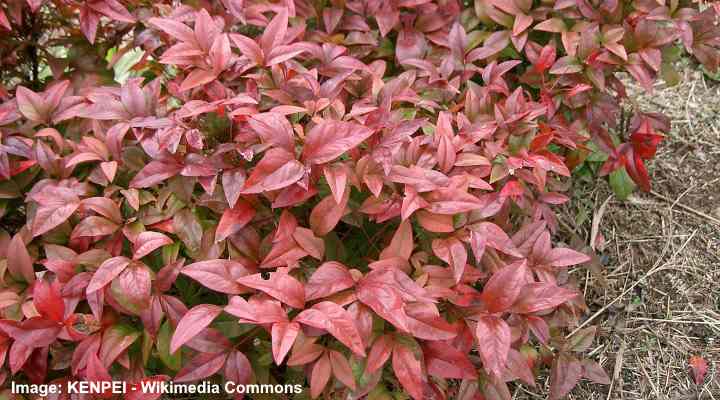
Nandina domestica ‘Otafukunante’
Nandina ‘Plum Passion’
Nandina ‘Plum Passion’ is a nandina shrub with reddish-purple foliage that decorates the erect stems in spring, fall, and winter. Clusters of small white flowers on the shrub mature into bright red berries. Nandina ‘Plum Passion’ grows 4 to 6 ft. (1.2 – 1.8 m) tall and up to 5 ft. (1.5 m) wide.
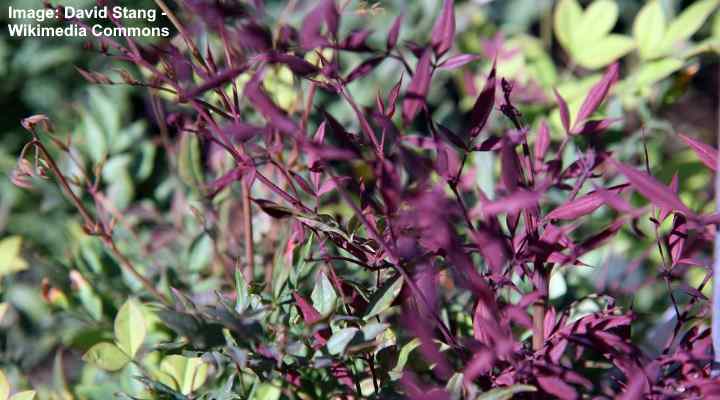
Nandina domestica ‘Plum Passion’
Nandina domestica nana ‘Firehouse’
Nandina domestica nana ‘Firehouse’ is a dwarf nandina shrub with compact mounding growth and bright green foliage that turns red in fall and winter. Grows to around 2 ft. (0.6 m) tall and wide. Nandina ‘nana’ shrub doesn’t flower or produce berries.
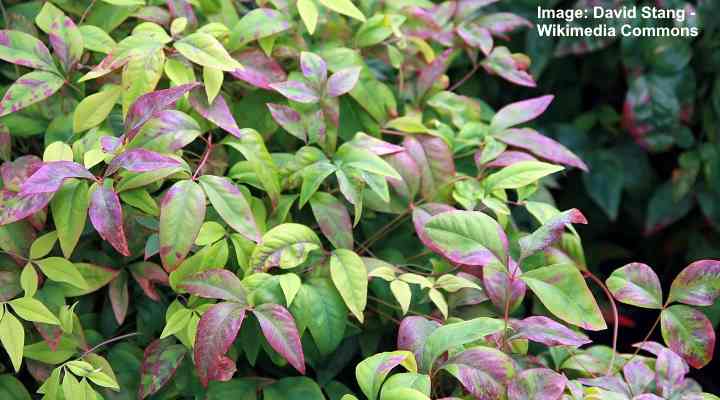
Nandina domestica nana Firehouse
Nandina Bush Berries
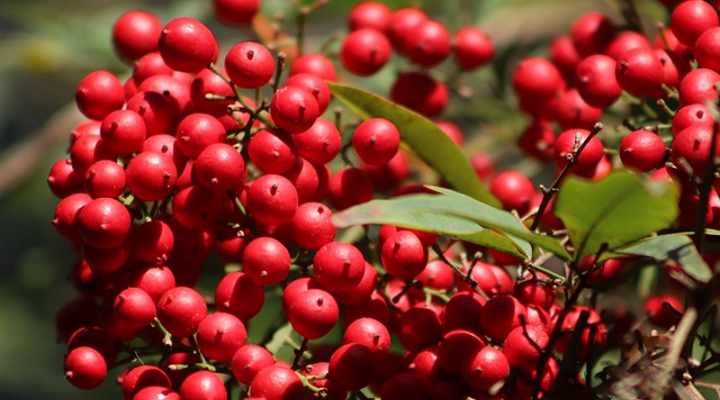
Nandina berries are poisonous to birds but there are non-flowering cultivars that don’t produce fruit
Most nandina shrubs are known for clusters of vibrantly colored red berries growing in dangling bunches like grapes. The red berries appear in the fall and persist throughout winter, giving nandina bushes year-long ornamental interest. Berries can be so abundant that they almost cover the colorful evergreen foliage.
Nandina Domestica Flowers
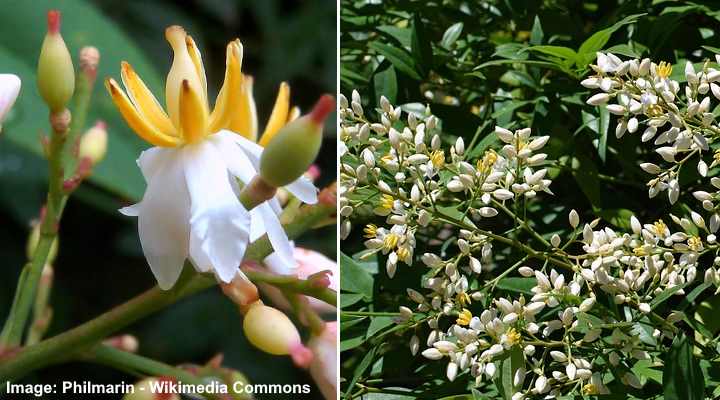
Nandina flowers
Most nandina shrubs produce clusters of small white or pinkish flowers that bloom in May and June. The tiny blooms measure up to 0.5” (1.2 cm) across and grow in clusters that measure 6” to 12” long (15 – 30 cm). Nandina bushes bloom better when grown in full sun, and the shrubs are grouped together.
Nandina Domestica Leaves
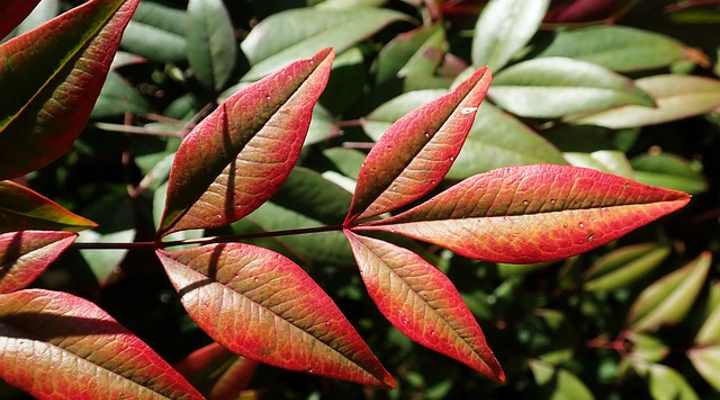
Nandina leaves
Leaves on nandina shrubs are compound pinnate leaves made up of several lance-shaped leaflets. Each leaflet measures 1” to 3” (2.5 – 7 cm) long, and the compound leaves can grow between 12” and 24” (30 – 60 cm) long. The evergreen nandina leaves usually emerge red, turn green, and then deep red, purple, or bronze in the fall.
Nandina Shrubs in Garden Landscapes
Thanks to its colorful foliage, heavenly bamboo brings plenty of ornamental value to a garden landscape. The shrub’s beautiful leaf texture and vibrant year-long colors, along with large clusters of red berries, make it useful for adding decorative value to a landscape.
Nandina shrubs grow well as an informal hedge, shrub border, or grouped with evergreen shrubs. Plant it in groupings or mass plantings to encourage plenty of flowers and berries to create the most impact. To add to your garden’s aesthetics, you can plant groups of nandina shrubs with different colored foliage.
For example, nandina ‘Gulf Stream’ is ideal as a backdrop landscaping plant. Its ever-changing foliage colors, white flowers, and red berries add plenty of interest to a landscape. Or you could choose nandina ‘Lemon Lime’ for its chartreuse foliage.
Nandina Care
A nandina shrub is easy to care for in a garden landscape. Apart from pruning to remove suckers that shoot up, nandina is a drought-tolerant plant that thrives in most soil types. The shrub-like bush thrives in full sun but will grow just as well in partial-shaded conditions.
Let’s look in more detail at how to grow this colorful decorative shrub in your garden landscape.
Where to Grow Nandina Bushes
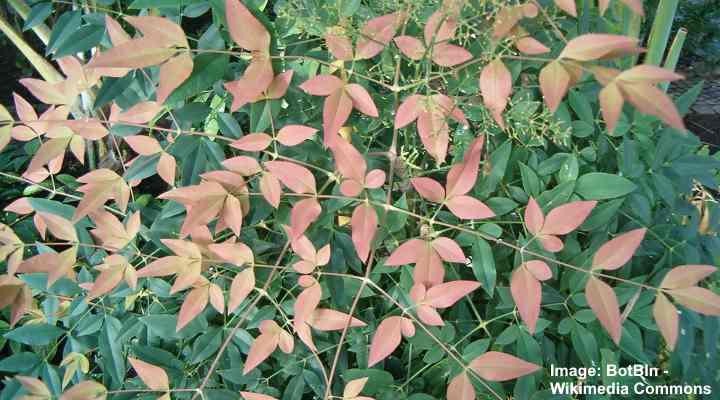
Nandina domestica shrubs grow best in full sun
To grow nandina shrubs in your garden, choose the sunniest spot where it can enjoy full sun. Nandina cultivars like the ‘Gulf Stream’ can withstand some shade. However, too much shade will affect flowering, and the bamboo-like canes can become sparse with little foliage. In zones 9 and 10, nandina benefits from some afternoon shade.
Planting in full sun with some afternoon shade helps ensure your bamboo-like shrub develops vibrant foliage. Evergreen nandina shrubs keep their leaves throughout winter. Some cold weather along with bright sunshine helps leaves develop tinges of red colors.
How to Grow Nandina Shrub
Nandina domestica cultivars are typically easy to grow in garden landscapes to enjoy year-long color. Ideally, it would be best to plant a nandina shrub in rich, moist soil that drains well. However, robust nandina plants adapt well to most soil types and even grow in poor conditions.
For optimal growth, it’s a good idea to keep the ground well-watered but not soggy. This is especially true during hot, arid conditions when rainfall is scarce. Even though nandina survives dry spells, its colorful foliage, flowers, and berries benefit from moist conditions.
The best way to ensure healthy growth is to water the ground often enough to keep the root area moist. When the top layer of soil is completely dry, give the shrub deep watering by drenching the ground. During winter, when growth is dormant, you should water nandina less frequently.
Generally, water heavenly bamboo weekly if there is no rainfall for seven days. Otherwise, occasional rain should be enough to keep the ground moist. Some mulch around the root base can also help lock in soil moisture.
A sign that a nandina bush needs watering is when the leaves start wilting or turn pale. Give the ground a thorough soaking to revive the shrub and encourage it to grow well.
How to Fertilize Nandina
Nandina shrubs benefit from applying fertilizer once a year in spring. Apply a balanced, slow-release fertilizer to help improve poor soil. You can use a fertilizer suitable for rhododendron or evergreen plants. After applying the fertilizer, water the soil thoroughly to prevent root burn.
However, it’s not usually necessary to apply fertilizer to nandina plants if the soil is fertile.
When and How to Prune Nandina Shrub
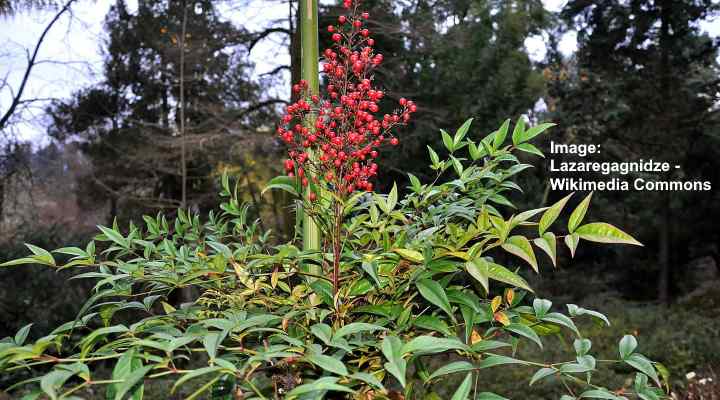
You can prune nandina domestica bush to control its size at any time of year
The most crucial aspect of nandina care is proper pruning. You can prune nandina plants at any time of year. Using sharp hand pruners, cut back old canes to the ground and prune other stalks to varying heights to keep the shrub’s appearance natural.
If a nandina shrub’s growth has gotten out of hand, you can prune stalks to one-third of their length every year for three years. This pruning technique helps to restore vigor to neglected “sacred bamboo” plants.
To cut back on garden work, you could also plant compact nandina cultivars. Some landscaping nandinas that don’t require pruning are ‘Flirt,’ ‘Obsession Nandina,’ and ‘Blush Pink.’
Transplanting Nandina
It is easy to transplant nandina from containers or dig up existing plants to transfer to another part of your garden. Nandina shrubs have fleshy roots making them easy to recover after transplanting.
The best time to plant a nandina in the ground is in the fall or winter when the weather is relatively cool.
If transferring nandina from containers to the ground, dig a hole big enough for the root ball. Ensure that the plant grows at the same height as before and fill in the remaining space with fertile soil and water well. Put a layer of mulch over the soil to help keep the ground moist.
Propagating Nandina
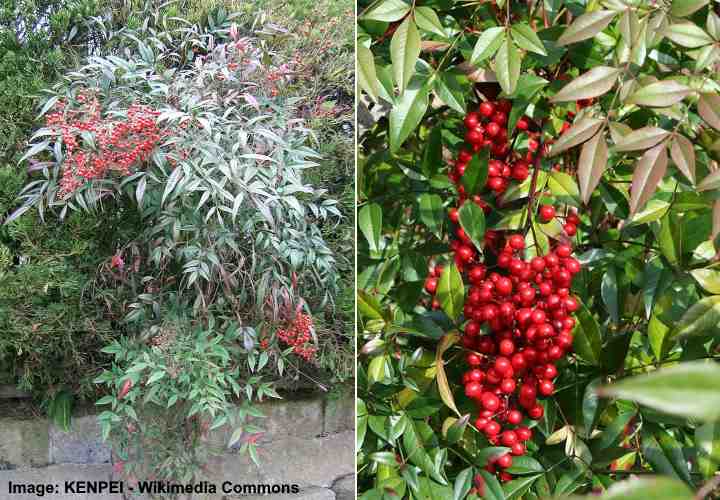
You can propagate nandina plant by softwood cuttings or dividing established plants
Nandina shrubs are easy to propagate from softwood cuttings.
All you need to do is cut a 6-inch (15 cm) length of tender stalk in early summer. Remove any leaves growing on the lower part and place the cutting in a pot containing peat moss. Lightly water the soil and seal the plant in a plastic bag to increase humidity. Keep the soil moist until roots have formed.
After a few weeks, you can transfer the rooted cuttings to your garden or a larger container.
Another way to propagate nandina is to divide established plants that send out suckers. Once the sucker shoots have a root system, you can dig them out from the parent plant and replant them in your garden.
Pests Affecting Nandina Growth
Nandina shrubs are relatively resistant to pests. However, sap-sucking mealybugs and whitefly can affect the shrub’s growth. Mealybugs look like white, fuzzy cotton-like growths under the foliage. Whiteflies also lurk under the leaves, and you can notice them flying if you shake the stems. Untreated, these pests can cause leaves to turn yellow and fall.
To eliminate pests from garden shrubs like nandina, it’s best to use a strong jet of water to dislodge the bugs. Additionally, making sure that growing conditions are optimal helps nandina resist mild pest infestations.
Related reading: How to make a DIY neem oil pesticide spray.
Diseases Affecting Nandina Growth
Under ideal conditions, disease rarely affects nandina shrubs. However, moisture issues with waterlogged soil or lack of air circulation can affect foliage and growth. Usually, resolving problems with watering and humidity helps to prevent further damage. It’s best to remove and destroy leaves or stems that show signs of disease.
For example, too much humidity and poor air circulation can cause powdery mildew—a white powdery substance on leaves. Although not detrimental to the shrub’s growth, it looks unsightly.
To avoid other fungal or bacterial diseases, it’s vital to water the shrub appropriately. Only water the ground when the top layer is dry. As with many shrubs that grow in subtropical climates, Nandina domestica withstands drought better than overly soggy soil.
Is Nandina Toxic?
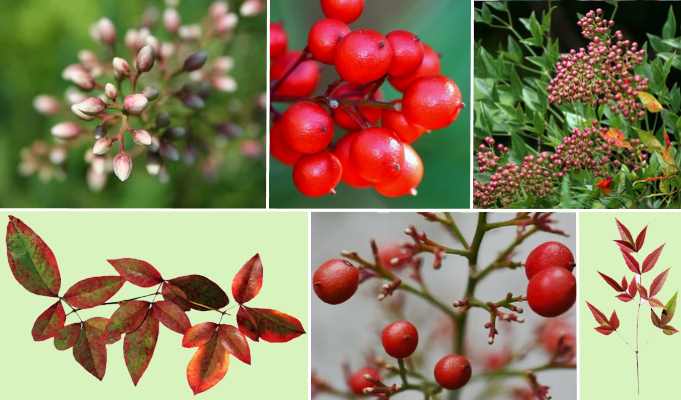
Nandina is poisonous to humans and animals
Nandina domestica is poisonous to cats, dogs, and birds. The ASPCA says that heavenly bamboo contains cyanogenic glycosides. Animals ingesting the berries or leaves can suffer vomiting, seizures, and respiratory failure.
It’s a good idea to avoid planting nandina shrubs if pets or children play in the garden. Doctors say that the red berries on this ornamental plant can cause gastrointestinal upset when eaten. Among the symptoms of eating nandina berries are vomiting, abdominal pain, diarrhea, and nausea.
Issues with Nandina Shrubs
The main issue related to growing nandina shrubs is their invasive nature. Nandina spreads vigorously by suckers, and their berries easily spread the seeds. Nandina shrubs can form dense thickets that crowd out native plants. However you can choose non-invasive nandina cultivars such as ‘Firepower’ or nandina ‘Obsession’.
Of course, if you have pets or children, the poisonous berries could pose a health risk. In this case you can choose a non-flowering cultivar that doesn’t produce berries.
Related articles:
